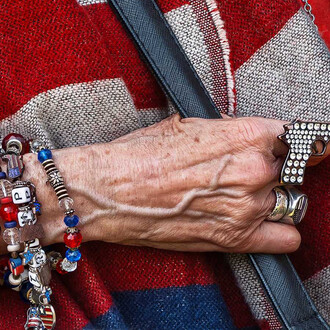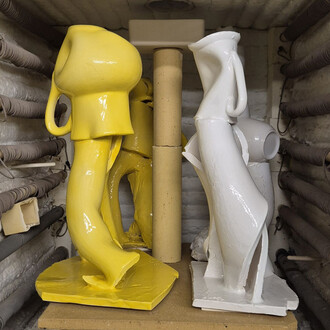Tigers, the new solo exhibition by Jossef Krispel, continues his study of painting depths, face and figure: mask, layers and shell. Krispel presents ideologies through the three icons: Dionysis, Picasso and David Bowie. These three figures are dynamic. They pose, pretend, have diversity, youth, passion and many common features. These faces act as an allegory for painting. The image creation of three characters reveals the position of the painting as a shell and fraud, deceiving the world that deals with vision.
Hung on the wall of Jossef Krispel’s studio is a medium sized painting with the words: Make-Up in print, erased with an elegant brushstroke, and beneath it, as if a handwritten correction, the word: Made-Up. A cosmetic correction. Both phrases have the same meaning: manipulations made to conceal the truth and conceal the face: make-up, mask, fake (as well as: fictional, invented, fabricated). Against the walls lean paintings of David Bowie’s made up face, “the artist with a thousand faces”, who changed identities and musical styles at a breakneck pace. Fernando Pessoa, who in his writings hid behind seventy different persona’s (several of them had names and fictional biographies), said that masquerading means knowing yourself, and “What a great happiness not to be me”. In his song Quicksand (from the album Hunky Dori) Bowie sings: “Don’t believe in yourself, don’t deceive with belief”. What or who hides behind David Bowie’s thousand masks? A virtuoso musician and performer, who's constant motion does not allow closing in with a label or finite definition, or rather a charming charlatan, empty and lacking in emotion, who juggles and deceives with his changing sexual identities?
The painting is a made-up canvas. Make-up is a mask made out of brilliant colors. On the table in the studio, near the easel lie many dozens of paint tubes, organized in lines: I count as many as twenty different greens. As well as reds, blues, flesh hues and yellows from the most highest quality and the most expensive brands: Old Holland, Gamblin, Williamsburg, and even Schminke, colors manufactured in Germany and not sold in Israel (incidentally the name in German means Make-up). The craft of the painter is that of a make-up artist, and vice-versa. The make-up artist is a painter whose canvas is the object of his observation. A thin layer of paint, flat and glittering, is laid upon the canvas with the same tools that serve the make-up artist (recently Krispel has begun painting with paintbrushes that were not meant for oil paint at all, gentle paintbrushes that bring to mind make-up brushes). The depth of the color is as deep as the make-up. If the painting is a made-up canvas/mask, then what is the true face of the painting? The naked canvas? And how odd it is that the word Fabric is the base for the word Fabricate, meaning to invent and concoct. And indeed, lies and fables are woven like fabrics. At its best - painting is illusion. The face of the painting is that of a mask, which it chose to wear.
Of Dionysus, the Greek god of mask and theater, it is told that whoever saw the true face underneath his mask would die or go mad. The moral of the story being: a mask enables viewing the “face”, and we shouldn’t try to uncover what lies behind masks. And in answer to the question on Bowie: David Bowie is the sum of all his masks. There is no other Bowie, or a real, authentic Bowie behind the masks. And Pessoa did not “hide” behind seventy personas. Pessoa is composed of those seventy personas.
Jossef Krispel’s paintings are made Alla Prima, meaning paintings that are created in one session, one shot. Even when the remains of a previous painting peek out from beneath a layer of paint, it is a previous painting that was rejected and covered with a new one. In French this technique is called Premier Coup, meaning a painting in the “First Strike”, the first try. The quick painting is perceived here as an action that has the air of primacy, a display of power and perhaps even violence. This action is habituated and very stylized. I think of a swordsman dancing in front of the canvas, battling it and scathing it with a long and pointy tool, with measured and exact movements. Indeed, Krispel’s painting is a performative painting, a painting that documents and reflects a body in a quick and vigorous, yet stylized and exact physical motion. It is painting that reveres the virtuosic. The language of painting Krispel uses creates breathtaking spectacles of gleam and perfection. This is not a painting of searching, indecision and a multilayered concoction, but a painting of a quick sleight of the hand, that ends as if magic in a complete and convincing image. As a rule, virtuosic painting attempts to distance itself from the finality and humanity of the painter. A painting of this kind does not manifest signs of effort and exertion. This casual appearance requires tremendous effort from the painter, yet is not to be revealed to the viewer. The virtuosic painter should be quick, viral and seductive.
Some of the greatest virtuosos- Frans Hals, Boucher, Tiepolo, Watteau, Fragonard … but also Picasso, Manet, Warhol and Richter – are painters with self confidence, lacking complexes or existential melancholy. Their paintings occur as if magic before the viewers wondering eyes. Vital and sensual, as if asking to outwit death with their eternal youth, knowing full well that incidentally the jeering grin of death, which treats all this shallow and glittering beauty as the beauty of a flower, that by the end of the day will wither and wilt, is reflected and stamped upon them. The excess effort for vitality and freshness creates the opposite effect. I recall the blood curling screams of the peacock in his most magnificent moments.
There is some of the Dionysian in the virtuosity with which David Bowie plays around with his characters, sexual identities and colorfulness. Because of his constant changes and transformations Dionysus is also considered the god of metamorphosis. Bowie, as a sphinx on one of Krispel’s canvases, is a metamorphosis of the hybrid essence: Half man (feminine, heavily made up), half dog. Picasso, Warhol and Richter (artists Krispel is in continuous dialogue with) have demonstrated through their careers how to reinvent yourself whenever you wish; the liberty to strip off or wear different shapes, to deceive those following you and to deny any possibility for one authentic identity. They have changing identities so as not to become a stylized and familiar brand. The freedom to paint a painting that is impersonal and synthetic denounces the option of a “natural” painting with an individual handwriting. This may be the reason why for a long time, painters have avoided signing the surface of their painting: as the signature might give in their hand writing and personal temperament.
On a second glance, I notice that the painting with the Make-Up / Made-Up inscription seems as a paraphrase to an early Ed Ruscha. I also remember that when Ruscha painted his first “inscription” paintings, he wished to assimilate Jasper Jones.
The history of painting is as that of a masquerade, taking place in a baroque mirror hall, where everyone is reflected into each other, countless times.
Noga Gallery
60 Ehad Ha'am st.
Tel-Aviv 65202 Israel
Tel. +972 3 5660123
info@nogagallery.com
www.nogagallery.com
Opening hours
Monday - Thursday 11am - 6pm
Friday - Saturday 11am - 2pm














